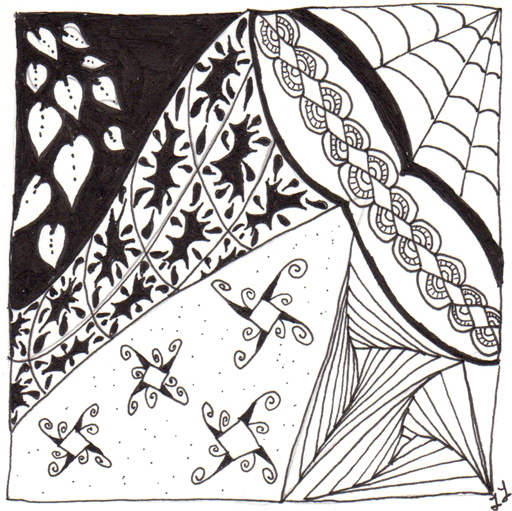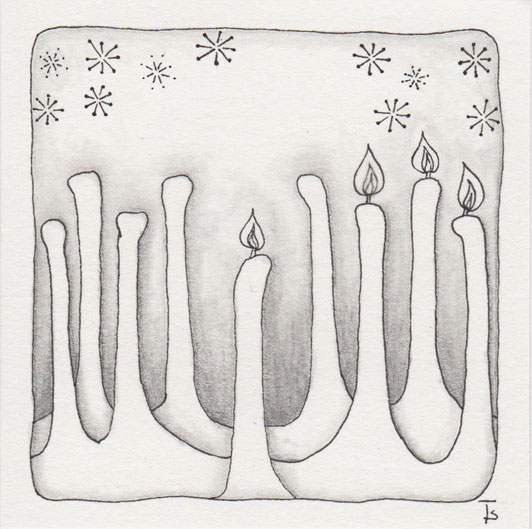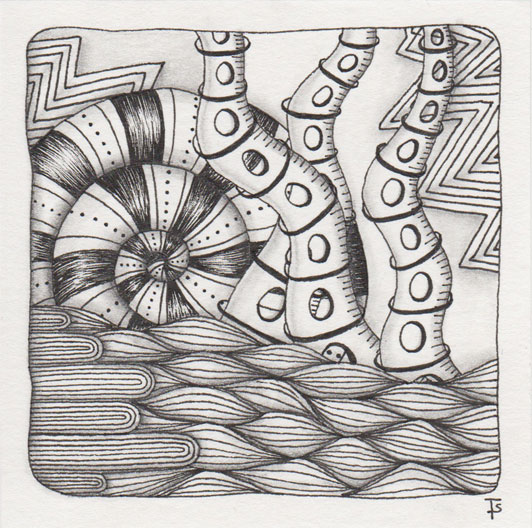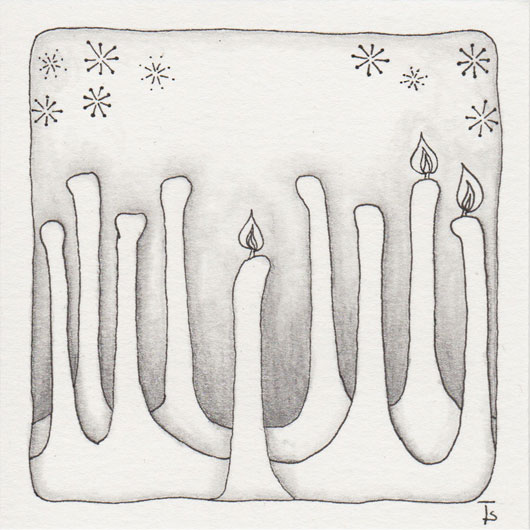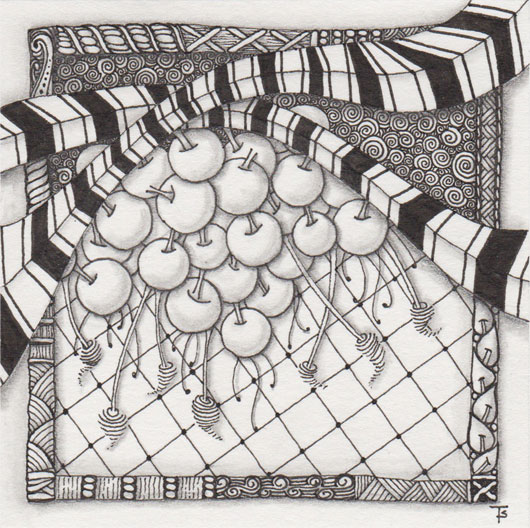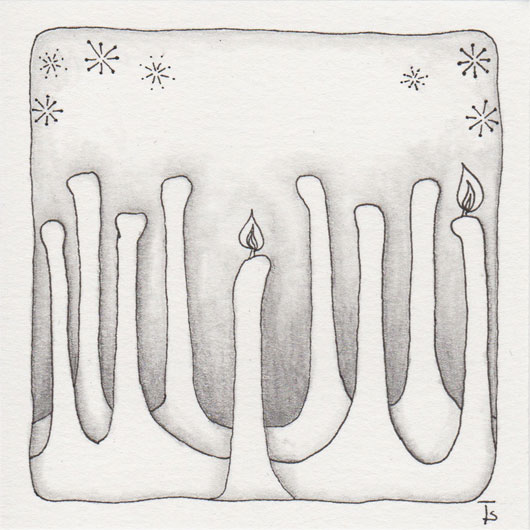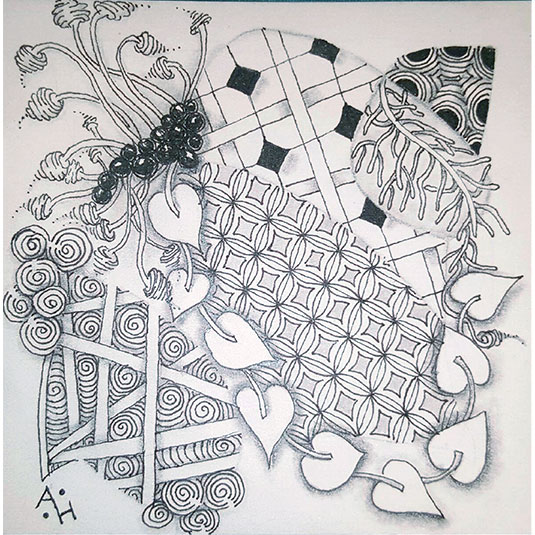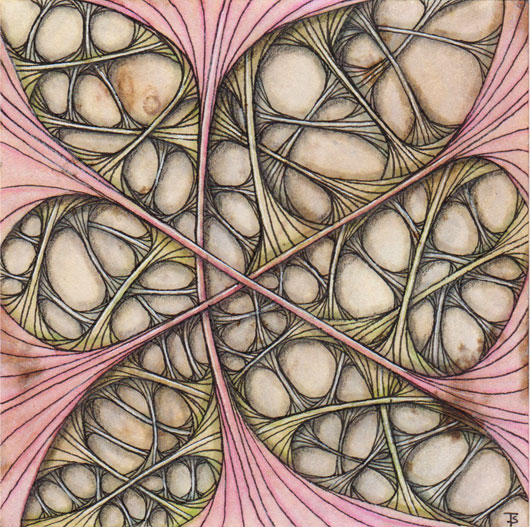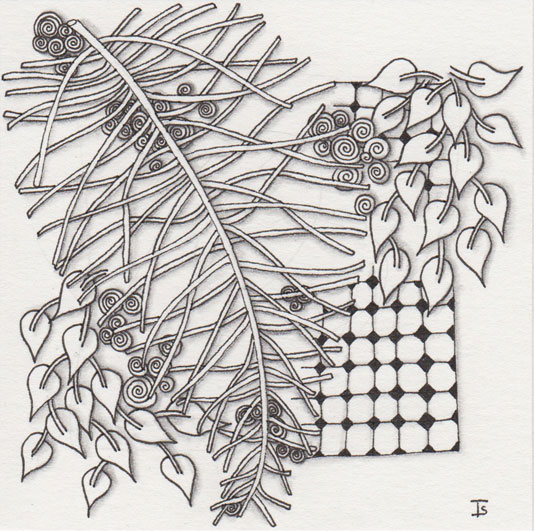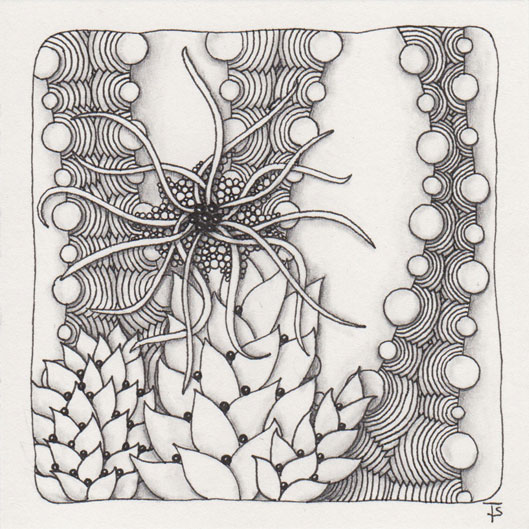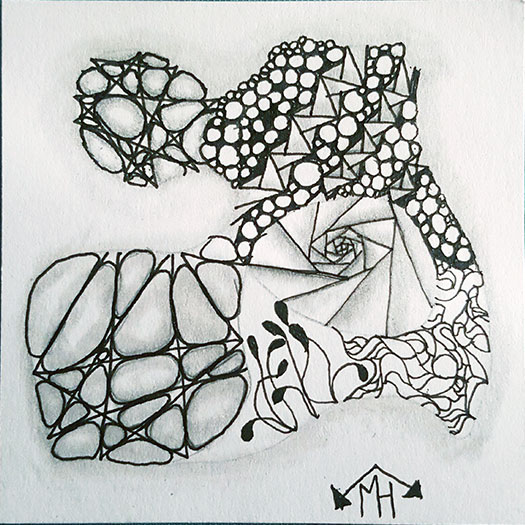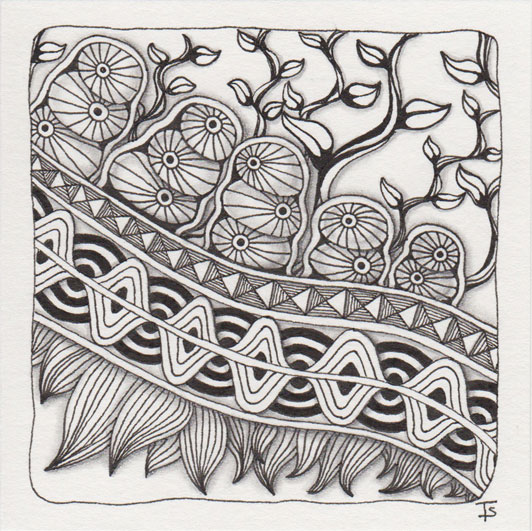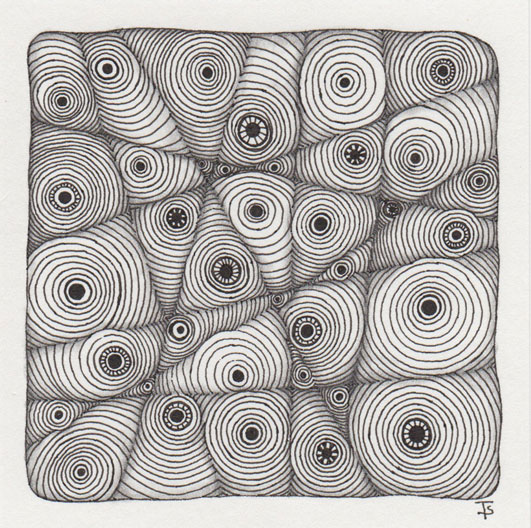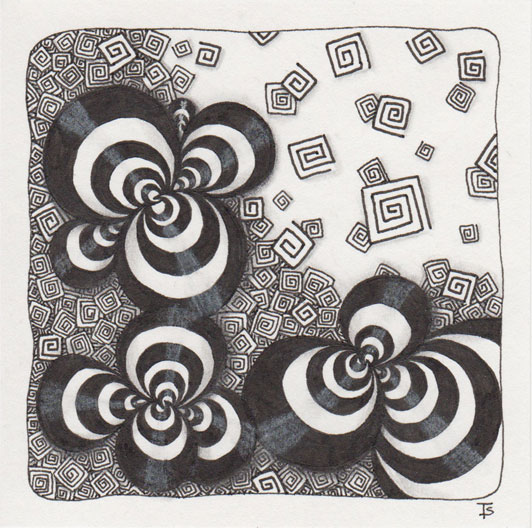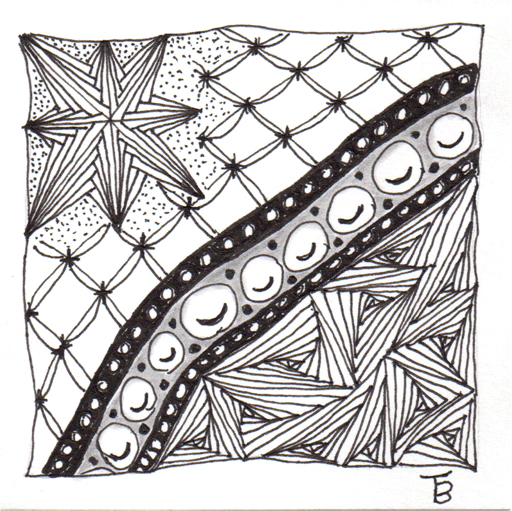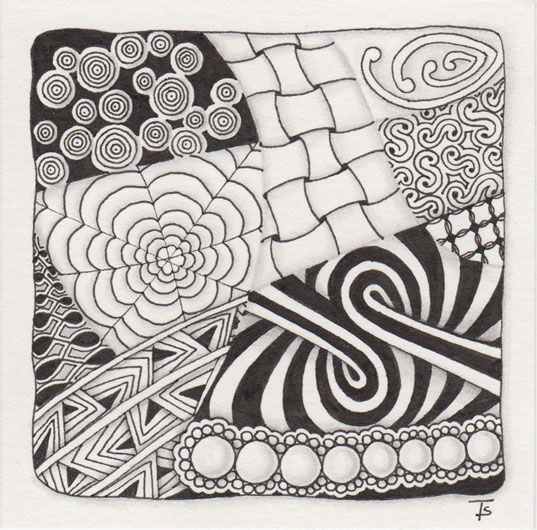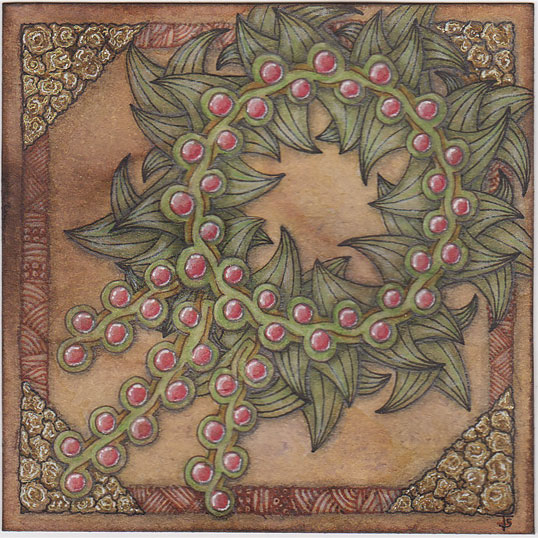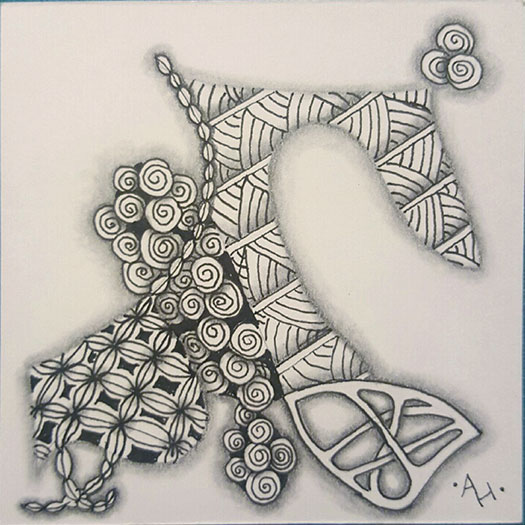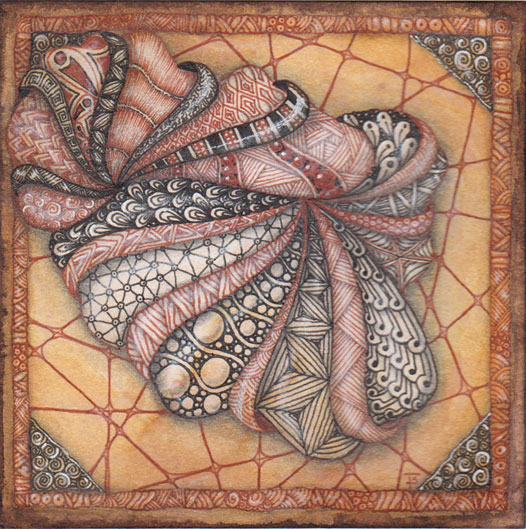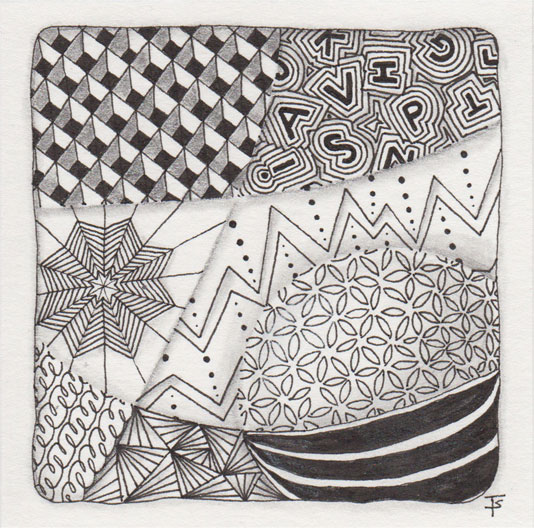A while back, I told you about various family members drawing Zentangles for my birthday in 2010. Today, I want to show you one drawn by my oldest daughter! I think she did a fantastic job!
You can see the other birthday Zentangles here !
Zentangle drawn on Strathmore Vellum Bristol using a black, Micron pen. Shading done with graphite pencil.
Sea Waves.
She watched the waves carefully, trying to see how the odd liquid could look so solid yet still propel the Shell Ship through the coral forest. The sea had such an odd texture she wasn’t even sure it WAS a liquid at all!
Zentangle drawn on Strathmore Vellum Bristol using a black, Micron pen. Shading done with graphite pencil.
Tangles: Coral Five Oh Marasu Sea Wave Static
From the Zentangle Primer: Lesson 3, page 55, Exercise #9. We are instructed to let our tangles extend beyond the border.
In my tile, above, I decided to extend Braze all the way to the very edge of the tile. It looks as if it was dropped onto the drawing. I made the border very definite by turning it into a tangled frame all around the center of the tile.
From the Zentangle Primer: Lesson 3, page 55, Exercise #8. For this string exercise we were to go “beyond the string,” and push past boundaries.
I think Amanda did a fantastic job, compared to her original string, which you can see below! I love the way her Pokeleaf meandered around part of the string and then went up and joined into the Verdigogh at the upper right!
Amanda’s talent and distinctive style is slowly emerging with each exercise that she does!
I combined several different techniques on this tile. I didn’t start out to make a Monotangle. Originally I was going to put a bunch of different tangles in the spaces between the largest Ruutz. But I just got into the zen of it and fractalized Ruutz down three iterations.
Then I decided to color the various levels. The top level I colored pink, the second was a lime green, and the smallest was a light blue-violet.
From the Zentangle Primer: Lesson 3, page 55, Exercise #8.
For this string exercise we were to go “beyond the string,” and push past boundaries.
I used the string as more of a comfort zone than as an actual string. I created the big Verdigogh “leaf” first, placing the central rib along a curved line that was part of my string. But I extended it past the outer bounding box.
“Just as the sun rose over the landscape, shards of yellow penetrated the deep blue water to reveal life beneath the sea. Tentacles of deep green seaweed danced to the music of the current. In the deepest depths of the water, life was awakened with the bright morning sun. Creatures of the sea revealed their secrets.” - Jo Flaherty
Jo posted this as a challenge on the ZIA Tips, Tricks and Techniques Group on Facebook.
This Zentangle was done by Matthew Higbee. Matt is a 17-year-old high school student and a second-year art student. You’ve seen another tangle he did, here , previously, if you’ve been following this blog.
I love that he decided to take off on his own, and used tangles that we haven’t been practicing yet. I think he made good choices, and the tangles have nice contrast between circular and angular.
Watchers.
As she walked through the marketplace, she admired all of the woven and embroidered trims on the awnings. Then, she noticed the Borbs, looking down at her above the spice vendor. It was such and alien reminder. This was not her home, not her planet.
Zentangle drawn on Strathmore Vellum Bristol using a black, Micron pen. Shading done with graphite pencil.
Tangles: Aloha Avreal Borbz Enyshou Unyun
Watchers.
They were part of the fabric of the planet. The watchers were everywhere she had been. In the buildings, they incorporated themselves into the corners and between the cornices. In the gardens, they often were at the heart of a blossom or hidden in the fold of a leaf. Even on the shorline, she found them nestled among the rocks. If one wasn’t diligent, one might even find them in the porridge or bread.
Passé data.
They fell from the sky as she watched from the tower. It looked as thought they were tossing out a mass of data chips before they landed. She wasn’t sure what good that would do… Nothing had worked since the pulse happened many years ago. Nobody cared. They were sick of the connections. The chips were pretty, though. Perhaps they could use the metals for adornment.
Zentangle drawn on Strathmore Vellum Bristol using a black, Micron pen.
Dementia is a terrible thing. It steals a person’s mind a little bit at a time… for a long time.
This Zentangle was created by my Mother-in-Law for my birthday in 2010. I was tangling with her very often, teaching her various tangles and techniques. I thought it would be good for her. She had had a heart attack and quadruple bypass surgery. She was on a lot of medication.
Christmas market.
She loved this time of year. Even the cold weather didn’t bother her. There were so many things to choose from: exotic fabrics and trims, fancy jewelry and decorations, beautiful baskets and ceramics. Even the colorful awnings and tents brought her joy!
Zentangle drawn on Strathmore Vellum Bristol using a black, Micron pen. Shading done with graphite pencil.
Tangles: Bales Criss & Cross Dyon Huggins Mooka Quipple Sez Shard Striping Tidings
This is another in the series of Tan Treasure tiles . I decided to combine the treasure tile with the Distressed tile technique. For the theme, I chose a wreath. It’s the time of year when we start decorating for Christmas, so I thought it would be appropriate.
In addition, Zailz was used because it is the focus tangle for this week for one of the Facebook Groups that I participate in.
From the Zentangle Primer: Lesson 3, page 55, Exercise #7.
In this lesson, we are learning about strings. For the first exercise, we are supposed to combine two (or more) sections of our string together to form a new section that is better suited for the tangle we want to use.
Here is what Amanda’s original string looked like, so you can compare it with her finished Zentangle above.
Giving thanks.
I have so many things to be thankful for this year, it would make a very long post to list them all. So I am going to tell you that I am grateful for my wonderful husband, beautiful daughters, and fabulous grandchildren. I am thankful for my good health and good life.
I also am very thankful that I discovered Eni Oken. She is a fabulous artist that shares herself, her talent and her knowledge with others.
Message.
She was sure there was something important hidden there. Perhaps a clue to the treasure. She searched the bowl of flowers, the cobwebs in the corners, the lattice- and the lace… Somehow she totally missed it.
Zentangle drawn on Strathmore Vellum Bristol using a black, Micron pen. Shading done with graphite pencil.
Tangles: Afterglow Chartz Cubine Eke Gourdgeous Muchin Quandry Vermal
